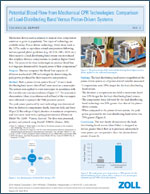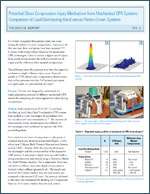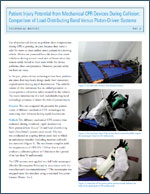Technology Overview
Blood Flow
Mechanical devices used as adjuncts to manual chest compressions continue to grow in popularity. Two types of technology are available today. Piston-driven technology, which dates back to the 1970s, seeks to produce sternal compressions following well-recognized global guidelines (e.g., ILCOR, ERC, AHA, etc.). More recently, load-distribution band technology was introduced that employs thoracic compressions to produce higher blood flow. The potential for these technologies to produce blood flow is in large part determined by the peak power of their compressions.
 |
Technical Report |
Chest Injury
It is widely recognized that patient injury can occur during the delivery of chest compressions. A review of the injury-related literature for mechanical CPR technologies reveals a higher rate of injury from piston-driven systems for both the overall rate of injury and the difference from manual compressions.
 |
Technical Report |
Patient Injury
Use of mechanical devices to perform chest compressions during CPR is growing, in part because they make it safer for crews to treat cardiac arrest patients in a moving vehicle. Medics are protected from the forces that create imbalance during normal travel and collisions since they remain safely belted in their seats while the device performs chest compressions. However, patient safety has been an issue. In the past, piston-driven technologies haven been problematic since their top-heavy design made their movement unpredictable during rapid deceleration. The recent introduction of a new load-distributing band technology promises lower risk of patient injury.
 |
Technical Report |
